The relationship between the U.S. and the Philippines has shaped the latter’s growth in profound ways. From historical ties to modern-day collaborations, the U.S. has played a pivotal role in the Philippines’ development. This partnership spans economic, political, and cultural spheres, leaving a lasting impact on the nation.
During the early 20th century, the U.S. introduced significant reforms in education and governance. These efforts laid the foundation for the Philippines’ progress. Today, the two countries continue to work together on trade, defense, and humanitarian initiatives, strengthening their bond.
Understanding this relationship is key to appreciating how the Philippines has evolved. This article explores the historical and contemporary contributions of the U.S. to Philippine development.
Key Takeaways
- The U.S. has influenced Philippine development through historical and modern collaborations.
- Education and governance reforms were key contributions during the early 20th century.
- Trade and defense agreements continue to shape the relationship today.
- Cultural exchanges have strengthened ties between the two nations.
- The Philippines’ independence in 1946 marked a new chapter in this partnership.
Introduction
The dynamic interplay between America and the Philippines has shaped the latter’s trajectory in significant ways. This article aims to shed light on the multifaceted role of the U.S. in Philippine development. From colonial roots to modern collaborations, the relationship has evolved into a robust partnership.
Understanding this bond requires examining key terms and historical contexts. The government policies of the U.S. have been instrumental in shaping the Philippines’ socio-economic landscape. Cultural exchanges have also played a pivotal role in strengthening ties between the two nations.
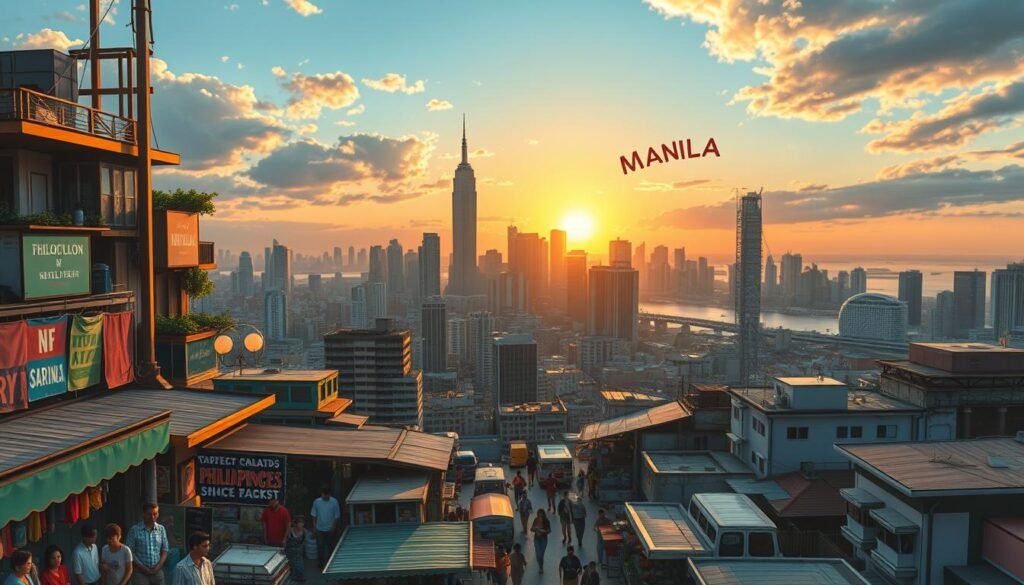
Historically, the U.S. introduced reforms in education and governance that laid the foundation for progress. Today, trade, defense, and humanitarian initiatives continue to define this partnership. The Philippines’ independence in 1946 marked a new chapter, but the influence of American ideals remains evident.
This section sets the stage for a deeper exploration of the relationship. It highlights the relevance of American contributions and guides readers through the evolution of this enduring bond. Below is a table summarizing key aspects of U.S.-Philippine relations:
| Aspect | Historical Contribution | Modern Impact |
|---|---|---|
| Education | Introduction of public school systems | Scholarship programs and academic exchanges |
| Governance | Establishment of democratic institutions | Policy collaborations and capacity-building |
| Trade | Economic reforms and infrastructure development | Major trade agreements and investment flows |
By examining these aspects, readers can appreciate the depth of the U.S.-Philippine relationship. The following sections will delve into specific areas of collaboration, providing a comprehensive understanding of this enduring partnership.
Historical Context of U.S.-Philippine Relations
From colonial beginnings to modern diplomacy, the Philippines’ journey has been shaped by external forces. The history of U.S.-Philippine relations is a story of transformation, marked by colonial policies, independence movements, and evolving partnerships.
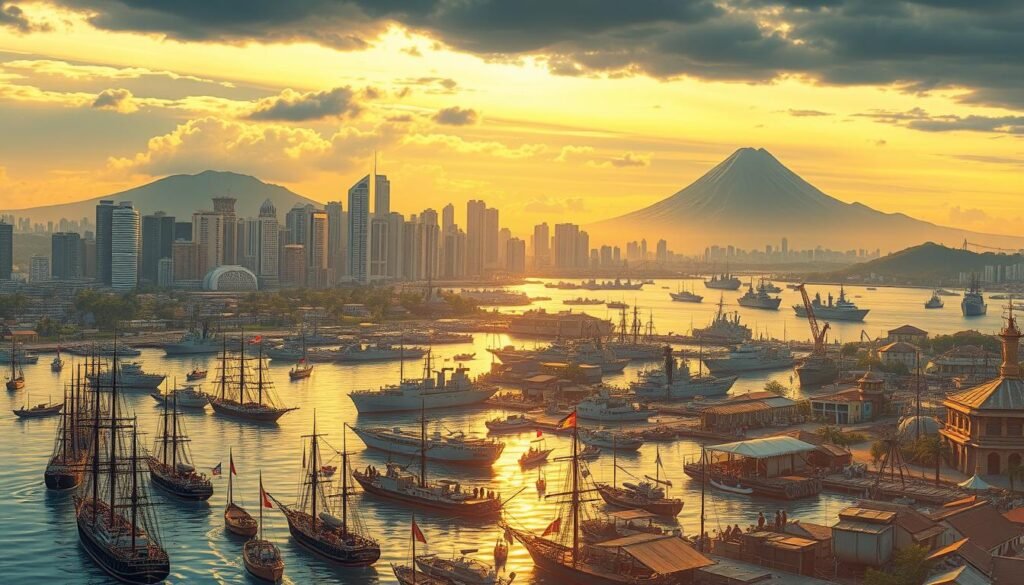
Colonial Legacy and Independence
American colonial rule in the early 20th century introduced significant reforms in education and governance. These changes laid the groundwork for the Philippines’ progress. However, the desire for self-rule grew stronger, leading to the nation’s independence in 1946.
The growing population of Manila, a bustling city, became a focal point for economic and political activities during this period. The Philippines’ quest for independence was fueled by a desire to reclaim its national identity and sovereignty.
Post-colonial Diplomatic Evolution
After gaining independence, the Philippines and the U.S. worked to redefine their relationship. Key treaties and reforms strengthened diplomatic ties, transforming the partnership from dominion to collaboration.
Historical milestones, such as the Mutual Defense Treaty of 1951, underscored the strategic importance of this alliance. Over time, the relationship evolved to address modern challenges, including trade, security, and humanitarian efforts.
This enduring bond reflects the resilience and adaptability of both nations, shaping the Philippines’ trajectory in profound ways.
Political and Economic Ties
Political and economic ties between the two nations have deepened over decades of cooperation. This partnership has been instrumental in shaping the Philippines’ governance and economic policies. From legislative exchanges to joint initiatives, the collaboration has been multifaceted and impactful.
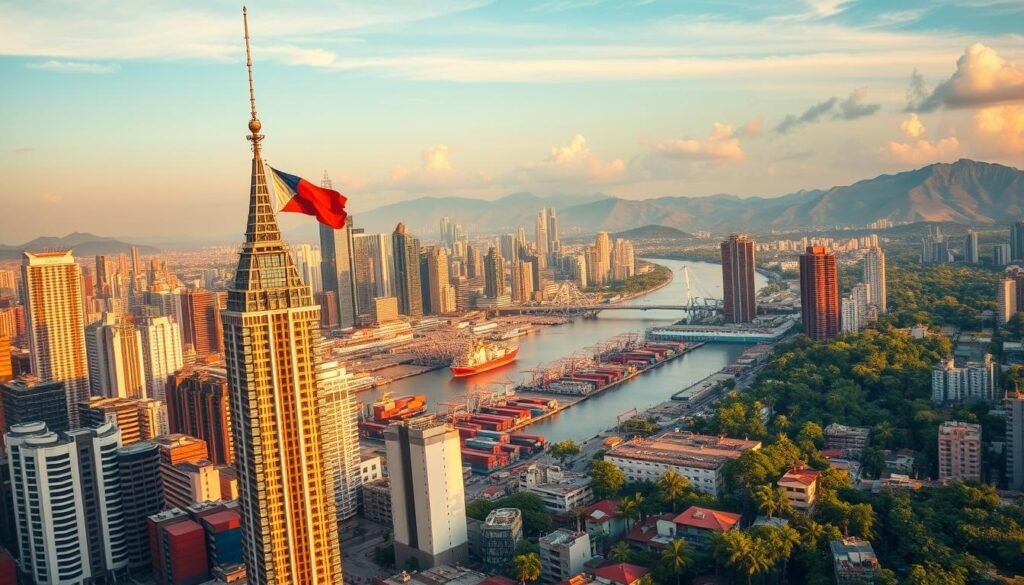
Government Collaboration and Policy Exchange
The U.S. has played a significant role in influencing political reforms in the Philippines. American policies have helped establish democratic institutions and strengthen public administration. Joint policy planning has been a cornerstone of this relationship, fostering transparency and efficiency.
One notable example is the Mutual Defense Treaty of 1951, which solidified strategic ties. This agreement has evolved to address modern challenges, including trade and security. The president of the U.S. has often been a key person in advancing these diplomatic efforts.
Legislative exchanges have also been vital. Both nations have worked together on capacity-building programs and institutional reforms. These initiatives have enhanced governance and economic stability in the Philippines.
- Joint policy planning has improved public administration.
- Legislative exchanges have strengthened democratic institutions.
- Strategic treaties like the Mutual Defense Treaty have enhanced security.
The United States America continues to support the Philippines through various initiatives. These efforts reflect a shared commitment to progress and stability. The enduring partnership remains a cornerstone of regional development.
Trade and Investment Impact
Trade and investment have been pivotal in shaping the Philippines’ economic landscape. Over the years, the U.S. has played a significant role in fostering economic growth through strategic agreements and capital inflows. These collaborations have not only boosted the country’s GDP but also enhanced its global competitiveness.
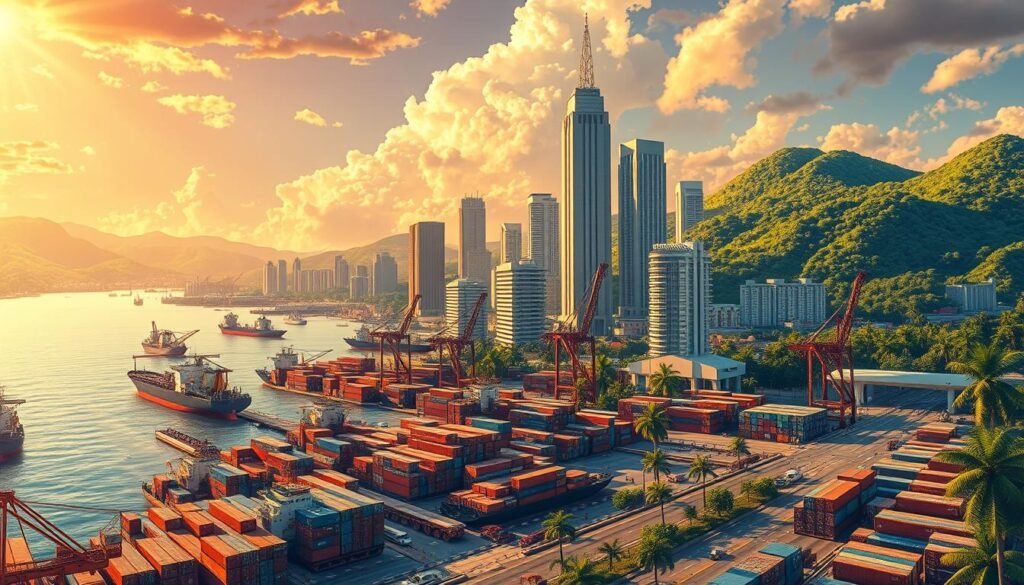
The relationship between the two nations has evolved into a robust partnership, driven by mutual economic interests. From technology to agriculture, American investments have introduced innovative practices and created job opportunities. This section delves into the major trade agreements and foreign investment trends that have defined this enduring bond.
Major Trade Agreements
Trade agreements between the U.S. and the Philippines have been instrumental in fostering economic stability. The Mutual Defense Treaty of 1951, for instance, laid the groundwork for deeper economic ties. More recently, the Trade and Investment Framework Agreement (TIFA) has facilitated discussions on reducing trade barriers and enhancing market access.
These agreements have had a tangible impact on the Philippines’ economy. For example, U.S. exports contributed significantly to the country’s GDP growth during the recovery period post-2009. Such collaborations highlight the power of bilateral trade in driving economic progress.
Foreign Investment Trends
American capital has been a driving force behind the Philippines’ economic transformation. Foreign direct investments (FDI) from the U.S. have flowed into key sectors such as technology, manufacturing, and agriculture. These investments have not only spurred innovation but also created millions of jobs.
For instance, U.S. companies have established manufacturing hubs in the Philippines, leveraging the country’s skilled workforce. This influx of capital has strengthened the Philippines’ position as a regional economic flagbearer. The benefits of these investments are evident in the country’s sustained economic growth and improved living standards.
- Trade agreements have reduced barriers and enhanced market access.
- Foreign investments have driven innovation and job creation.
- Key sectors like technology and agriculture have benefited significantly.
These trends underscore the importance of the U.S.-Philippine economic partnership. By fostering trade and investment, both nations continue to reap the rewards of this enduring collaboration.
Cultural Influences and Americanization
American culture has left an indelible mark on the Philippines, shaping its societal norms and daily life. From entertainment to education, the influence of American ideals like freedom and innovation has been transformative. This section explores how media, education, and linguistic exchanges have integrated American values into Filipino culture.
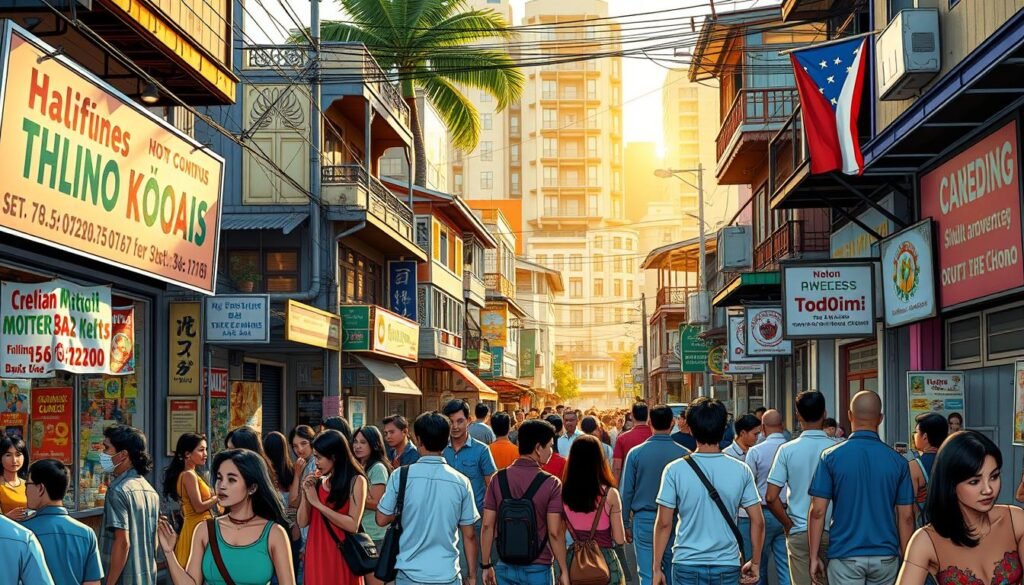
Media and Entertainment Impact
American pop culture has become a cornerstone of Filipino youth culture. Movies, music, and digital media from the U.S. dominate local entertainment. For instance, American films account for a significant portion of box office revenues in the Philippines. This cultural exchange has introduced new ideas and lifestyles, reshaping societal norms.
Television shows like CSI and Friends are widely popular, influencing fashion and language. The spread of American media has also created a demand for English-language content, further strengthening linguistic ties. This cultural exchange has been a resource for creativity and innovation in the Philippines.
Educational and Linguistic Exchanges
Education has been a key area of cultural exchange. American-style schools and scholarship programs have introduced Filipino students to U.S. educational practices. These programs emphasize critical thinking and creativity, aligning with American ideals of freedom and self-expression.
English, as a second language, has become a bridge between the two cultures. Linguistic exchanges have facilitated academic collaborations and professional opportunities. For example, many Filipino professionals work in Alaska and other U.S. regions, bringing back skills and knowledge that benefit local communities.
| Aspect | Cultural Influence | Impact |
|---|---|---|
| Media | American films and TV shows | Shaped youth culture and language |
| Education | Scholarship programs and exchanges | Enhanced critical thinking and skills |
| Language | English as a second language | Facilitated global opportunities |
These cultural exchanges highlight the enduring influence of American values on Filipino society. By embracing these elements, the Philippines has enriched its own cultural identity while fostering a deeper connection with the U.S.
United States: Security and Defense Alliances
Security and defense alliances have been a cornerstone of the Philippines’ strategic growth. These partnerships have not only ensured regional stability but also strengthened the country’s ability to address modern security challenges. From military assistance programs to joint exercises, the collaboration has been transformative.

Military Assistance Programs
The U.S. has provided significant military aid to the Philippines, enhancing its defense capabilities. Programs like the Mutual Defense Treaty and the Enhanced Defense Cooperation Agreement have allowed access to advanced equipment and training. These initiatives have been crucial in countering terrorism and improving disaster response.
For instance, the expansion of the Enhanced Defense Cooperation Agreement grants access to nine strategic sites. This collaboration has bolstered the Philippines’ defense infrastructure, ensuring readiness for any threat. Such partnerships highlight the importance of international support in maintaining peace.
Joint Security Exercises
Joint exercises between the armed forces of both nations have strengthened tactical cooperation. Training programs focus on counterterrorism, maritime security, and disaster relief. These exercises not only enhance skills but also foster trust and camaraderie among troops.
One notable example is the annual Balikatan exercises, which involve thousands of personnel. These drills simulate real-world scenarios, preparing forces for emergencies. The success of these initiatives underscores the value of strategic alliances in addressing global security challenges.
- Military aid programs have modernized the Philippines’ defense systems.
- Joint exercises enhance tactical skills and foster collaboration.
- Strategic agreements ensure access to advanced resources and training.
These efforts demonstrate the enduring partnership between the two nations. By working together, they continue to safeguard regional stability and promote peace.
Educational and Technological Partnerships
Collaborative efforts in education and technology have transformed the Philippines’ development landscape. These partnerships have not only bridged gaps but also opened new opportunities for growth. By fostering academic exchanges and technology transfer, the Philippines has strengthened its position in the world.

Higher Education Exchanges
Academic collaborations between the Philippines and other nations have been pivotal. Scholarship programs and research projects have allowed Filipino students to gain new skills and knowledge. These initiatives have also facilitated cultural exchanges, enriching the educational experience for both sides.
For instance, the YouthWorks initiative has provided over 11,000 training slots since 2018. This program focuses on equipping youth with skills in renewable energy and food services. Such efforts highlight the importance of investing in human capital for long-term development.
Innovative Technology Transfer
Technology transfer initiatives have played a crucial role in boosting the Philippines’ industrial and economic growth. Programs like the Enhanced Defense Cooperation Agreement include provisions for sharing advanced technologies. These efforts have helped modernize key sectors, from agriculture to manufacturing.
One notable example is the Tools Competition, co-financed by global foundations. This initiative supports local ed-tech projects, ensuring they meet international standards. By adopting best practices, the Philippines has become a hub for innovation in the region.
| Initiative | Impact |
|---|---|
| YouthWorks | Over 11,000 training slots for youth |
| Tools Competition | Supports local ed-tech projects |
| Enhanced Defense Cooperation Agreement | Facilitates technology transfer |
These partnerships demonstrate the power of collaboration in driving progress. By leveraging educational and technological exchanges, the Philippines continues to thrive in a rapidly changing world.
Environmental and Resource Cooperation
Environmental cooperation has become a cornerstone of sustainable development in the Philippines. Collaborative efforts between the U.S. and the Philippines focus on managing natural resources and protecting ecosystems. These initiatives aim to conserve habitats, reduce ecological degradation, and promote renewable energy.

The federal government has played a significant role in supporting these projects. Programs like the Enhanced Defense Cooperation Agreement include provisions for technology transfer and resource management. These efforts have introduced innovative practices in agriculture, forestry, and renewable energy sectors.
Sustainable Resource Management Initiatives
Sustainable resource management is a key focus of this partnership. Joint projects aim to address challenges like illegal fishing, deforestation, and climate change. For example, the U.S.-Peru Trade Promotion Agreement includes measures to combat illegal logging, setting a precedent for similar initiatives in the Philippines.
Technology-driven solutions have also been implemented. Renewable energy projects, such as solar and wind farms, have been developed with U.S. expertise. These initiatives not only reduce carbon emissions but also create job opportunities for local communities.
“Sustainable development is not just about protecting the environment; it’s about creating a future where people and nature thrive together.”
Here are some key achievements in environmental cooperation:
- Introduction of renewable energy projects to reduce reliance on fossil fuels.
- Collaborative efforts to combat illegal fishing and logging.
- Capacity-building programs to enhance local expertise in resource management.
| Initiative | Impact |
|---|---|
| Renewable Energy Projects | Reduced carbon emissions and job creation |
| Anti-Illegal Logging Measures | Preserved forests and biodiversity |
| Capacity-Building Programs | Enhanced local expertise in sustainability |
These efforts highlight the importance of international collaboration in achieving sustainable development. By leveraging U.S. expertise, the Philippines continues to make strides in environmental conservation and resource management. For more insights, explore sustainable resource management programs.
Urban Development and Infrastructure
Urban development in the Philippines has seen transformative changes in recent years. Drawing inspiration from global models, including those from New York City, the country has embraced modern urban planning initiatives. These efforts aim to create sustainable, efficient, and livable cities for the growing population.
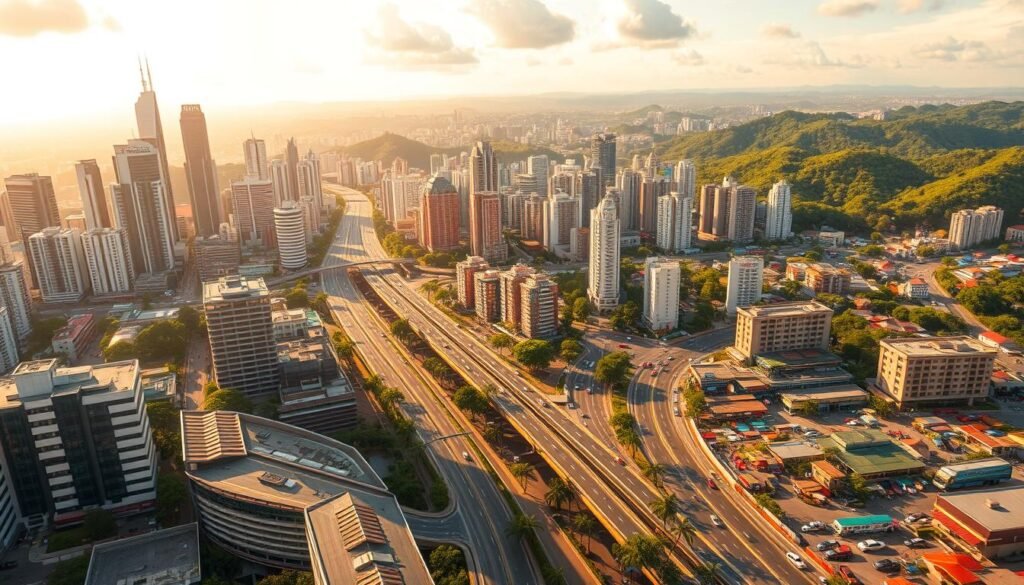
One of the key areas of focus has been the development of transportation networks. Major cities like Manila and Cebu have invested in modernizing their public transit systems. Projects such as the Metro Manila Subway and the Cebu Bus Rapid Transit are set to reduce congestion and improve mobility.
Modern Urban Planning Initiatives
Smart city projects are at the forefront of urban transformation. These initiatives leverage technology to enhance public services, from traffic management to waste disposal. For example, the Quezon City Smart City project uses data analytics to optimize resource allocation and improve citizen engagement.
Sustainable urban design is another critical aspect. Green spaces, energy-efficient buildings, and renewable energy sources are being integrated into city planning. These efforts align with global trends and aim to reduce the environmental impact of urbanization.
Case studies of urban transformation highlight the influence of American urban planning principles. The 21st century approach emphasizes inclusivity, resilience, and innovation. These principles are evident in projects like the Bonifacio Global City, a model of modern urban development.
- Transportation networks are being upgraded to reduce congestion and improve mobility.
- Smart city projects use technology to enhance public services and resource management.
- Sustainable urban design integrates green spaces and renewable energy sources.
These initiatives are supported by programs like those administered by the Department of Housing and Urban Development, which promote affordable housing and community development. By adopting best practices, the Philippines is building cities that are not only modern but also inclusive and sustainable.
Governance and Democratic Values
Democratic values have long been a guiding force in shaping governance worldwide. The Philippines, in particular, has drawn inspiration from U.S. models to strengthen its institutions. This collaboration has led to significant reforms aimed at enhancing transparency and accountability.
One of the key areas of influence has been the promotion of open governance. U.S. initiatives, such as the Freedom of Information Act, have inspired similar measures in the Philippines. These efforts ensure that citizens have the right to access government data, fostering trust and participation.
Institutional Reforms and Transparency
Transparency has become a cornerstone of Philippine governance. Reforms have focused on reducing corruption and improving public service delivery. For example, the establishment of the Anti-Red Tape Authority has streamlined bureaucratic processes, making them more efficient and citizen-friendly.
Legislative exchanges between the U.S. and the Philippines have also played a crucial role. Policies promoting civil liberties and democratic practices have been adopted locally. These include measures to protect freedom of speech and ensure fair elections.
- Transparency initiatives have increased public access to government information.
- Anti-corruption measures have improved trust in public institutions.
- Legislative reforms have strengthened civil liberties and democratic practices.
The impact of these reforms is evident in the growing confidence of citizens in their government. By embracing democratic values, the Philippines continues to build a more inclusive and sustainable future.
Economic Growth and Global Influence
From post-World War II recovery to modern trade agreements, the U.S. has shaped the Philippines’ economic trajectory. This partnership has not only boosted national growth but also positioned the Philippines as a key player in global markets. By leveraging American economic models and fiscal policies, the country has achieved significant milestones in infrastructure and industry development.
Washington’s influence is evident in the Philippines’ economic indicators. For instance, U.S. investments have driven advancements in technology and manufacturing. These contributions have created jobs and enhanced the nation’s competitive edge. The Mutual Defense Treaty of 1951 also laid the groundwork for economic stability, fostering a climate conducive to growth.
American culture of innovation has inspired local industries to adopt best practices. This cultural exchange has led to the development of sustainable business models and increased productivity. The Philippines’ ability to integrate these practices has strengthened its position in the global economy.
Trade agreements between the two nations have further solidified this partnership. For example, the Trade and Investment Framework Agreement has reduced barriers and expanded market access. These initiatives have not only benefited the Philippines but also contributed to the U.S. economy, showcasing the mutual advantages of this collaboration.
To understand how the U.S. became a global power and its impact on global dynamics, explore this resource. This historical context highlights the enduring influence of U.S. policies on nations like the Philippines.
Challenges and Criticisms
The U.S.-Philippine relationship has faced its share of challenges and criticisms over the years. While the partnership has brought significant benefits, it has also sparked debates and controversies. Public sentiment and policy discussions often highlight tensions tied to military presence, political influence, and economic dependencies.
Public Sentiments and Policy Debates
Public opinion in the Philippines has been divided on the role of the U.S. in the country’s development. Some view American intervention as a necessary support system, while others see it as an infringement on sovereignty. Policy debates often center around the territory’s autonomy and the extent of foreign influence.
For instance, the presence of U.S. military bases has been a contentious issue. Critics argue that these bases undermine local governance and create security risks. Supporters, however, highlight their role in regional stability and disaster response. These differing perspectives reflect the complexity of the relationship.
“The challenge lies in balancing national sovereignty with the benefits of international partnerships.”
Controversies and Economic Dependencies
Economic dependencies have also been a point of criticism. The Philippines’ reliance on U.S. trade and investment has raised concerns about long-term sustainability. Critics argue that this dependency limits the country’s ability to pursue independent economic policies.
Political influence is another area of debate. Some believe that U.S. policies, often shaped by congress, prioritize American interests over Philippine needs. This perception has fueled calls for a more balanced and equitable partnership.
- Military presence has sparked debates on sovereignty and security.
- Economic dependencies raise concerns about long-term sustainability.
- Political influence is seen as prioritizing U.S. interests over local needs.
Domestic and International Responses
Domestically, the Philippines has seen growing calls for self-reliance and reduced foreign influence. Internationally, other nations in the west have scrutinized U.S. policies in the region. These responses highlight the need for a more nuanced approach to bilateral relations.
| Issue | Domestic Response | International Response |
|---|---|---|
| Military Presence | Calls for reduced foreign bases | Scrutiny of U.S. regional strategies |
| Economic Dependencies | Push for diversified trade partners | Concerns about economic imbalances |
| Political Influence | Demands for equitable partnerships | Criticism of U.S. policy priorities |
These challenges underscore the importance of addressing criticisms and fostering a more balanced relationship. For further insights, explore U.S. foreign policy issues and their global impact.
Future Prospects in Philippine Development
The future of Philippine development is poised for transformative growth through strategic partnerships. Emerging technologies, economic forecasts, and educational collaborations are driving this evolution. These initiatives aim to create a sustainable and inclusive future for the nation.
Innovative approaches and pilot projects are signaling the next phase of economic and infrastructural progress. For instance, the Philippine Rural Development Project has already benefitted over 1.3 million farmers and fisherfolk. Such efforts highlight the potential for scaling up successful models.
Emerging Opportunities
Technological innovation is at the forefront of emerging opportunities. Programs like the Access to Sustainable Energy Project have provided electricity to over 200,000 people. These initiatives not only improve quality of life but also create job opportunities in rural areas.
Educational partnerships are another key area. Scholarship programs and academic exchanges are equipping the youth with skills for the future. For example, the YouthWorks initiative has trained over 11,000 individuals in renewable energy and food services.
Trade and cultural exchange are also redefining the bilateral relationship. The Trade and Investment Framework Agreement has reduced barriers, fostering economic growth. These collaborations are paving the way for a more interconnected future.
Strategic Roadmaps for Progress
Strategic roadmaps are essential for maximizing development benefits. The Fourth Disaster Risk Management initiative has trained local governments in disaster preparedness. Such programs ensure resilience in the face of climate challenges.
Infrastructure development remains a priority. Projects like the Metro Manila Subway are set to reduce congestion and improve mobility. These efforts align with global trends in urban planning and sustainability.
Here’s a summary of key initiatives and their impact:
| Initiative | Impact |
|---|---|
| Philippine Rural Development Project | Benefitted 1.3 million farmers and fisherfolk |
| Access to Sustainable Energy Project | Provided electricity to 202,500 people |
| YouthWorks Initiative | Trained 11,000 youth in renewable energy |
These roadmaps highlight the importance of collaboration in achieving sustainable development. By leveraging strategic partnerships, the Philippines is building a brighter future for its people.
Conclusion
The enduring partnership between the two nations has shaped the Philippines’ development in profound ways. From the 20th century reforms to modern collaborations, this relationship has left a lasting legacy. Political strategies, cultural exchanges, and economic ties have driven progress, making the Philippines a key player in the region.
Despite challenges, the partnership has achieved significant milestones. The nation has benefited from technological advancements, educational programs, and sustainable initiatives. However, balancing sovereignty with collaboration remains a critical term for future growth.
Looking ahead, opportunities for continued cooperation are vast. By leveraging shared values and innovative approaches, both nations can address global challenges. For more insights on strategic pathways, explore this resource.
Ultimately, the Philippines stands as a testament to the power of partnership. With a focus on inclusivity and resilience, the future holds promise for further progress and mutual benefit.
FAQ
What is the historical context of U.S.-Philippine relations?
The relationship dates back to the colonial era when the Philippines was under American rule. After gaining independence in 1946, diplomatic ties evolved, focusing on mutual interests in security, trade, and cultural exchange.
How do political and economic ties benefit both nations?
Collaboration between the two governments includes policy exchanges and joint initiatives. These efforts strengthen democratic values, economic growth, and institutional reforms in the Philippines.
What are the major trade agreements between the U.S. and the Philippines?
Key agreements include the Generalized System of Preferences (GSP) and the U.S.-Philippines Trade and Investment Framework Agreement (TIFA). These promote bilateral trade and investment opportunities.
How has American culture influenced the Philippines?
Media, entertainment, and educational exchanges have significantly shaped Filipino culture. English language adoption and American-style education systems are prominent examples.
What role does the U.S. play in Philippine security and defense?
The U.S. provides military assistance and conducts joint security exercises with the Philippines. These efforts enhance regional stability and strengthen defense capabilities.
Are there educational and technological partnerships between the two countries?
Yes, higher education exchanges and technology transfer programs foster innovation and skill development. These partnerships benefit sectors like science, engineering, and information technology.
How do both nations collaborate on environmental issues?
Initiatives focus on sustainable resource management, disaster preparedness, and climate change mitigation. Joint efforts aim to protect natural resources and promote eco-friendly practices.
What urban development projects have been influenced by the U.S.?
Modern urban planning initiatives, supported by American expertise, have improved infrastructure, transportation, and public services in Philippine cities.
What challenges exist in U.S.-Philippine relations?
Public sentiments and policy debates sometimes highlight concerns about sovereignty, economic dependency, and cultural influence. Addressing these issues is crucial for sustained collaboration.
What are the future prospects for Philippine development with U.S. support?
Emerging opportunities include expanded trade, technological innovation, and strategic roadmaps for progress. Continued partnership aims to drive economic growth and global influence.
Source Links
- Philippines – US Influence, Colonialism, Revolution | Britannica
- Milestones in the History of U.S. Foreign Relations
- The U.S.-Philippines Defense Alliance
- United States | History, Map, Flag, & Population | Britannica
- United States
- Philippines–United States relations
- Historical Documents – Office of the Historian
- US, Micronesia deepen political and economic ties
- Foreign relations of the United States
- U.S. Relations With the Philippines – United States Department of State
- Economy & Trade
- The "Globalization" Challenge: The U.S. Role in Shaping World Trade and Investment
- Americanization
- "Americanization": An East Asian Perspective
- Austin: U.S. Leadership, Alliances Make for a More Secure World
- Major Non-NATO Ally Status – United States Department of State
- A Partnership Industry for Impactful Ed-Tech (SSIR)
- Science, Technology, and Innovation – United States Department of State
- USAID and Local Partners Launch New Partnerships for Youth Training Ahead of National Tech-Voc Day
- Environment & Natural Resources
- Commission for Environmental Cooperation
- Resource Panel
- U.S. Department of State – Home
- The Public, the Political System and American Democracy
- 2. Views of American democratic values and principles
- 21(1)-01(p.21-39).fm
- The U.S. Economy in Global Context
- U.S. Strategy and Economic Statecraft: Understanding the Tradeoffs
- Inflection Point: The Challenges Facing Latin America and U.S. Policy in the Region
- Criticism of the United States government
- Navigating the Challenges of the U.S. Political Landscape
- Overview
- United States and Philippines Sign New Php10.5-Billion Agreement to Boost Economic Growth and Development
- Conclusion of the 28th U.S.-Vietnam Human Rights Dialogue
- Conclusion – National Security Secrecy

